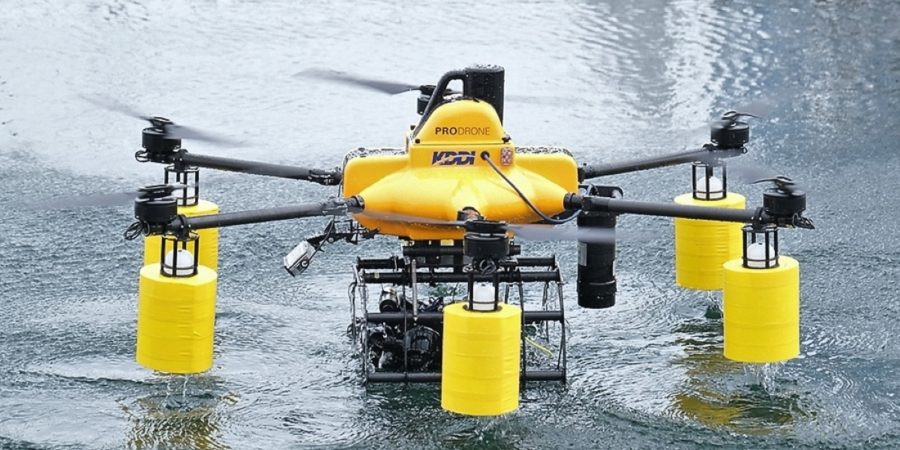This Drone Was Made to Work in Both the Air and the Sea
BY Zacc Dukowitz
20 January 2022A new drone made in Japan can operate both in the air and in the water.
Called the “Sea-Air Integrated Drone,” the drone is the creation of a collaboration between commercial drone company ProDrone, telecom company KDDI, and underwater robotics company QYSEA, all of which are based in Japan.
The drone was made primarily to support marine inspections, allowing inspectors to collect visual data remotely.
The three companies have reportedly been working on it for six years.
How Does the Sea-Air Integrated Drone Work?
The drone is actually a two-in-one solution—that is, it’s a heavy-duty flying drone that carries a swimming drone.


Credit: QYSEA
The flying drone is made so it can land on water, and then open a quick-release cage to deploy the swimming drone. The aerial drone is made by ProDrone, and the marine drone is made by QYSEA (it’s a drone they already manufacture, called the FIFISH PRO V6 PLUS ROV).
Here are the primary industries that could benefit from this new drone:
- Aquaculture. Monitoring oceanic livestock and crops, as well as performing maintenance and repair work through the underwater drone’s multitude of add-on tools.
- Conservation. Collecting marine data for scientific research.
- Maritime Inspections. Inspecting submerged portions of large vessels (primarily hulls) or other related infrastructure as needed.
- Offshore Wind Power. Performing complex inspection and maintenance work on the frames and foundations of offshore wind turbines.
- Oil & Gas inspections. Inspecting submerged parts of offshore oil rigs and FPSOs.
- Search & Rescue. Looking for missing people and signs of wreckage in and below the ocean.
How Will the Drone Be Used?
The goal for the Sea-Air Integrated Drone drone is to “modernize offshore and marine operations” so that robotics can be used instead of people for potentially dangerous marine work.


Credit: QYSEA
Underwater inspections are typically done in-person, with a team of inspectors using a boat for transportation to the inspection location.
Once there, inspectors will dive in order to collect data for their inspections. The goal of these inspections is to determine the conditions of the asset they’re inspecting, which could be an offshore platform or the hull of a boat.
But this approach to underwater inspections is slow, expensive, and potentially dangerous for inspectors.
Like several other inspection scenarios, such as inspections in confined spaces or at height, drones can help improve the inspection process by taking the place of the inspector.
Using a drone to collect visual data remotely, inspectors can remain at a safe distance from the operation, an approach that makes the inspection faster, less expensive, and—most importantly—safer, since the inspectors don’t have to endanger themselves to collect the data they need. And the Sea-Air-Integrated Drone presents the same benefits for underwater inspections as aerial drones do for other types of inspection work.
Here’s how it will be used in the field:
- Fly to the inspection location. Using long-range mobile communications, the drone can fly a preset route to a destination on the water.
- Deploy the underwater drone. Once the aerial drone has landed on the water it deploys the underwater drone, which can then be directed to the location where work needs to be done in that area.
- Collect the data and/or make repairs. Inspectors navigate the underwater drone to the places where they need to collect visual data, allowing them an up-close view of the conditions there that could otherwise only be possible by diving—or they use the drone to make repairs.
After inspectors collect data with the underwater drone they’ll work with maintenance team members to make determinations about whether any of the defects identified in that data are in need of repair.
One remarkable aspect of the Sea-Air Integrated Drone is that it can apparently perform some of this maintenance work itself. According to a statement from QYSEA, the primary uses for the Sea-Air Integrated Drone are “inspection, maintenance, and repair work underwater.”
Inspection work will be supported by the underwater drone’s camera, which will allow inspectors to both live stream and record visual data. And maintenance and repair work will be supported by “a variety of sampling, measurement, and manipulation tools” (this is all the information we’ve been able to find about these tools so far).
We’d love to know more about these tools—the ability to have a drone that can actually perform repairs is significant, and could have far-reaching implications not just for marine work, but for several other types of work that call for maintenance and repairs.


